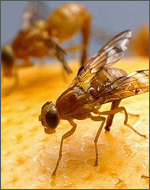

|
Wound Response in Drosophila
Wednesday, January 28, 2009 | Science
Wound healing, or wound repair, is the body's natural process of regenerating dermal and epidermal tissue. When an individual is wounded, a set of complex biochemical events takes place in a closely orchestrated cascade to repair the damage. These events overlap in time and may be artificially categorized into separate steps: the inflammatory, proliferative, and remodeling phases (Some authors consider healing to take place in four or more stages, by splitting different parts of inflammation or proliferation into separate steps.).
- In the inflammatory phase, bacteria and debris are phagocytized and removed, and factors are released that cause the migration and division of cells involved in the proliferative phase.
- The proliferative phase is characterized by angiogenesis, collagen deposition, granulation tissue formation, epithelialization, and wound contraction.
- In angiogenesis, new blood vessels grow from endothelial cells.
- In fibroplasia and granulation tissue formation, fibroblasts grow and form a new, provisional extracellular matrix (ECM) by excreting collagen and fibronectin.
- In epithelialization, epithelial cells crawl across the wound bed to cover it.
- In contraction, the wound is made smaller by the action of myofibroblasts, which establish a grip on the wound edges and contract themselves using a mechanism similar to that in smooth muscle cells. When the cells' roles are close to complete, unneeded cells undergo apoptosis.
- In the maturation and remodeling phase, collagen is remodeled and realigned along tension lines and cells that are no longer needed are removed by apoptosis.
While the skin, or epidermal barriers, of Drosophila and mammals are constructed in largely different ways, they share a common genetic pathway that controls their bodies wound response system.
Joseph C. Pearson and a team of biologists from the University of California at San Diego, using Drosophila, have discovered evidence that sheds new light on how our bodies heal themselves, and indicates just how complex our biological systems really are.
Drosophila is a genus of small flies, belonging to the family Drosophilidae, whose members are often called "fruit flies" or more appropriately (though less frequently) pomace flies, vinegar flies, or wine flies, a reference to the characteristic of many species to linger around overripe or rotting fruit. They should not be confused with the Tephritidae, a related family, which are also called fruit flies (sometimes referred to as "true fruit flies"); these feed primarily on unripe or ripe fruit, with many species being regarded as destructive agricultural pests, especially the Mediterranean fruit fly. One species of Drosophila in particular, D. melanogaster, has been heavily used in research in genetics and is a common model organism in developmental biology. Indeed, the terms "fruit fly" and "Drosophila" are often used synonymously with D. melanogaster in modern biological literature. The entire genus, however, contains about 1,500 species and is very diverse in appearance, behavior, and breeding habitat. Scientists who study Drosophila attribute the species' diversity to its ability to be competitive in almost every habitat, including deserts.

|


|

